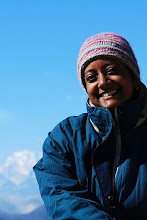The irony of 2013 –
I always imagined that being self-employed would give me a lot of time to
travel, but, reality was that it left me with neither time nor money. In a
flash of brilliance, I planned a few trips around a timeshare membership which
had been lying unused for aeons. This was my saviour for the year, as it
allowed me to enjoy a few vacations without pinching my pocket.
The other defining
characteristics of this year’s holidays - most were road-trips, some were
work-related travel and one was so spontaneous that I’m still surprised I went.
My trusty 9-year old car was a constant companion for more than 35 days on the
road this year.
I can’t be sure what
the rest of 2014 has in store for me, but, I’m beginning the new year with a
much-awaited trip; yet another road-trip. From being a paranoid road-traveller,
I’m discovering how having the right company on a road-trip can make it my
favourite way of travelling; hands-down.
Karnataka & Goa road-trip
18 days and 2300 kms
- I enjoyed my first-ever road-trip so much that it set the tone for the other
holidays this year. Restricting my travel to a section of coastal and North-west
Karnataka, 18 days gave me enough time to soak-in the flavour of the region. Of
course, with Goa being just a hop-skip-jump away, we couldn’t resist a few days
in South Goa before returning to Karnataka.
A sneak peek at my myriad
experiences in Karnataka, which I now call home:
Other stories from this trip:
For planning your trip, read the trip log here:
Bhadra
I’d visited Bhadra
for the first time as a part of my Karnataka road-trip. When some work took me
back there, I was only too happy to go. Though working meant that I could not
go on any safaris, I enjoyed every minute of spending time by the water,
surrounded by the raucous calls of hundreds of River Terns nesting and
hatching.
Read about Bhadra here:
Chasing the monsoon
A friend was on
assignment in South Kerala, awaiting the onset of the South-west monsoon. One
particularly tedious day at work, the photographs she kept sharing with a bunch
of us led to furious planning during the lunch break. Tatkal tickets and a quickly-packed
bag of monsoon gear in hand, two of us set off to join her, without a return
ticket; the most whimsical I’ve ever been. The next five days were spent chasing
the monsoon; rather, chasing the chaser of the monsoon. This impromptu trip has
given me one of my most memorable experiences - watching the monsoon wall move
towards land whilst standing on a deserted fishing beach, soon being smacked on
the face by piercing rain and uninhibitedly jumping and screaming in the
ensuing storm, soaked to the gills.
Read about
some of my other monsoon experiences:
http://nomadandabag.blogspot.com/2013/09/under-my-umbrella.html
http://nomadandabag.blogspot.com/2013/09/under-my-umbrella.html
Kerala road-trip
I returned to Kerala
towards the end of the monsoon. This time, the trip revolved around a
long-standing desire to see the famous snake-boat races of Kerala. We drove long-distance
from Bangalore, through Cherai, Alleppey, Kumarakom and Thekkady, for 11 days. Disappointingly,
the organisation of the Nehru Trophy boat race left much to be desired, though
the sheer muscle power of the rowers kept me spellbound. I also discovered that Thekkady is no longer
the pristine, quiet forest it used to be, in my memory from 15 years ago.
However, the night trek through the Periyar Tiger Reserve despite a sprained
foot, a gravity-defying Kalaripayattu performance and emerald monsoon vistas made
the trip worthwhile.
Two back-to-back
trips to Bandipur on work gave me the opportunity to spend time in a forest I
hadn’t visited that often before. The proliferation of Lantana and Parthenium
has reduced the visibility of the forest floor, but, birds, plants and insects gave
me more than enough to focus on.
Hogenakkal Falls
‘Niagara of the east’
or ‘smoky rock’ – whatever you choose to call Hogenakkal Falls, it does make
for an enjoyable day trip from Bangalore. The river Cauvery winds her way
across the two states fighting over her, creating a spectacular cascade on each
side. The ‘Karnataka falls’, the ‘Tamil Nadu falls’, coracle rides through picturesque
gorges connecting them, oil massages by the water and fresh, fried fish sold by
enterprising vendors – Hogenakkal has options to keep everybody happy.
 |
| The 'Karnataka Falls' |
Thadiyandamol, Coorg
Coorg’s highest peak
deserves its own special trip. And, no amount of time will suffice. Four days
spent on and around Thadiyandamol revealed the profusion of life it supports –
birds, reptiles, fungi, flora and other fauna. It also made us very aware of every
joint and muscle we possessed, the sad fallout of sedentary city life. But, to
share the pain, to hobble around together, to make exciting discoveries at
every turn, to pluck leeches off ourselves each evening, and to lounge around with
coffee and snacks after a very exhausting day, were a bunch of friends. It made for a very memorable birthday.
 |
| Kurinji, Sholas and a dragonfly, at Thadiyandamol |
Read about my Thadiyandamol trek, here:
http://nomadandabag.blogspot.com/2015/08/thadiyandamol-trek-ground-beneath-my.html
Read about other trips to Coorg:
http://nomadandabag.blogspot.com/2014/12/a-river-runs-through-it.html 

































